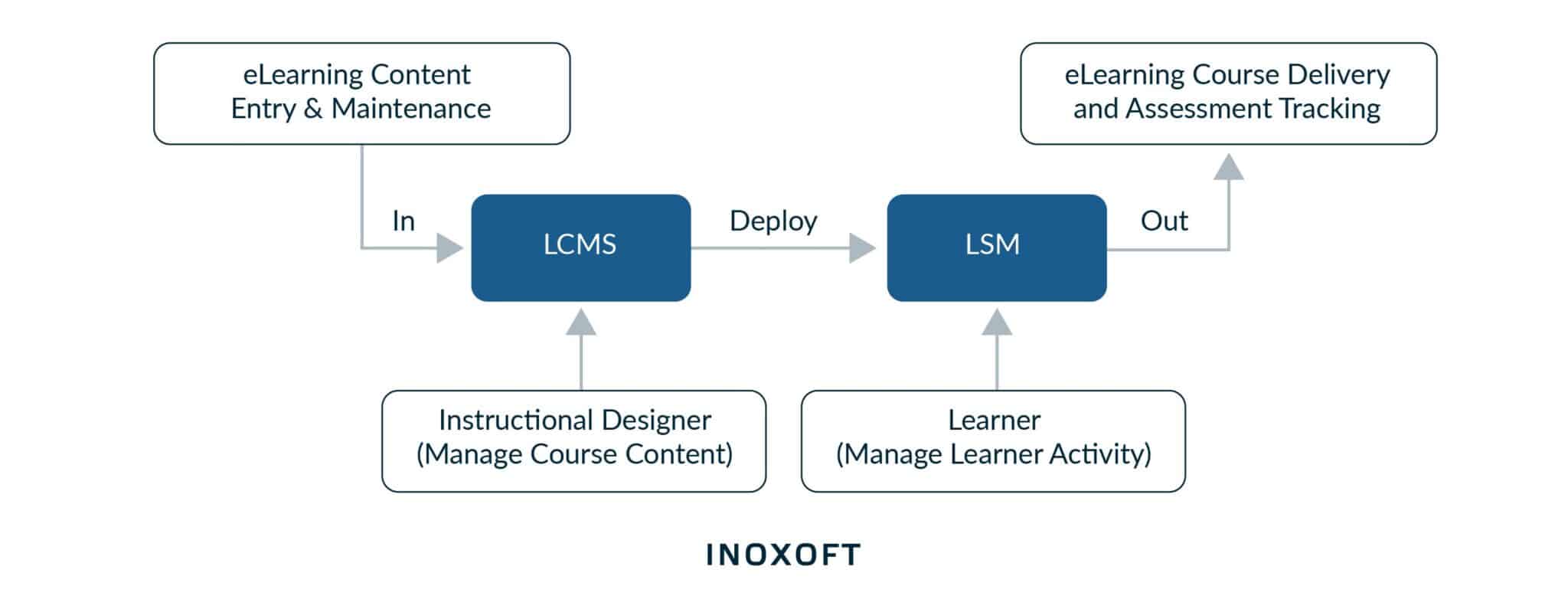What is the current situation in the e-learning market? According to Research.com, in Europe, the LMS market is expected to generate the second-highest revenue. In the Asia Pacific, the LMS market has increased at a CAGR of 34.2%.
What’s more, there are over 73.8 million active LMS users today. That’s why 90% of learners prefer online learning to a traditional one. Among the LMS buyers, 30% are the long-established tech giants. Here, 65% of executives and 35% of managers are primarily involved in LMS training.
So, having growth in all aspects of EdTech and 100% demand, let’s find out the LMS and LCMS difference together!
Education will never stop being one of the focus topics of this blog especially when it is supported by the most innovative technologies worldwide. So far, we have spoken about how to create an LMS and the different LMS. Also, we have discussed enterprise LMS solutions and how to create an educational app. This time, let’s compare lcms vs lms.
- What are LMS and LCMS?
- When do you need an LMS
- When do you need CLMS
- Similarities and Differences Between LMS and LCMS
- Similarities
- Differences
- LMS and LCMS Features Comparison
- How to Choose the Right Platform: LMS or LCMS?
- 1. Consider eLearning requirements
- 2. Prefer LMS when you need to
- 3. Prefer LCMS when you have
- Consider Inoxoft to Empower Your E-Learning Project
- Final Thoughts
What are LMS and LCMS?
A learning management system (LMS) is a type of software application that allows educational courses, training programs, or learning and development programs to be
- Administrated
- Documented
- Tracked
- Reported
- Automated
- Delivered
When do you need an LMS
The choice of the learning management system has been quite a challenge for businesses. But, if you put all the factors in place, you will surely get what you need. Consider LMS vs LCMS when it comes to:
| Need | to share training, education, or support materials with others |
| Target users | corporate and academic learners, and learning managers |
| Industries | LMS is useful in any environment where workers must learn new information to do their jobs well |
| Type of business | businesses seeking to engage with their team and distribute information, but without the hassle of calendar invites and conference room scheduling |
A Learning Content Management System (LCMS) is an integrated platform specifically designed for multiple users, administration possibilities, authoring, and delivery. Online training activities are being admin-
- Hosted
- Scheduled
- Managed registrations
- Assessed
- Tested
- Tracked
When do you need CLMS
On the contrary, LCMS vs LMS has another applicability. If you need major support of tools to help manage your content, then consider LCMS. For example:
|
Need |
help organizations manage large amounts of integrated web content via tools and add-ons |
|
Target users |
learning content creators (admins, designers) |
|
Industries |
eLearning |
|
Type of business |
small, medium, enterprise |
Similarities and Differences Between LMS and LCMS
Learning management system vs learning content management system are the two platforms that have different applicability in the eLearning processes. But, being with several similarities, the differences they have might be vague. Let’s discuss their characteristics separately to clarify the similarities and differences between LMS and LCMS.
Similarities
Among the similar features of LMS vs LCMS, you can find:
- Authoring and delivering content
- Supporting different content types
- Existing content templates
- Collaborating on learning content
- Searching for content in an advanced way
- Gathering analytics and sending reports
- Supporting SCORM and xAPI eLearning standards
- Accessing platforms on mobile devices
Differences
Learning management systems focus mainly on making learning available for learners and tracking the latter. Learning content management systems, in turn, focus on storing online content, managing it, and reusing it via an integrated database functionality. You might spot a slight overlap in the functionality between the learning content management system and the learning content management system. But, still, the primary focus of each is different. Let’s have a look:
LMS makes the process of scheduling classes, creating catalogs, and registering learners more efficient.
LCMS focuses only on delivery.
In the broadest terms, the learning management system helps get you to the classroom door and the learning content management systems manage the experience inside the classroom.
LMS and LCMS Features Comparison
To provide the most visible LMS and LCMS features comparison, it is vital to understand what features are there to compare.
|
Features |
Learning Management System |
Learning Content Management System |
|
Primary user |
Training managers, instructors, admins |
Content developers, designers, project managers |
|
Purpose |
Manage:
Capture:
|
Author learning content:
|
|
Data storage |
Storage of data on both courses and students |
Storage of content in a learning object repository |
|
Output |
Provide reports for training results and competency mapping/skill gap analysis |
Offer content management tools (e.g., search for learning objects, access rights, and version control) |
|
Content delivery |
Support the launch of e-Learning courses |
Deliver learning content in multiple formats:
|
|
Content management |
Capture and track knowledge elements |
Develop multiple courses using Reusable Learning Object |
|
Data sharing |
Share learner data with the ERP system |
— |
|
Add-ons |
Offer the ability to create and administer tests |
Offer learning features:
|
Now, you are more aware of the features each platform supports. This LMS and LCMS comparison still depends on what you need for your business. Both systems may be easy and hard to develop based on your needs and requirements. Consider our Inoxoft app calculator to understand what resources are to be used and how much you can pay for an LMS or LCMS.
How to Choose the Right Platform: LMS or LCMS?
Before setting up your mind on what to choose – LMS versus LCMS, consider the type of your organization, eLearning purpose, available budget, and possible timeframes.
1. Consider eLearning requirements
Some of the eLearning requirements may be to
- Manage learners
- Availability of catalog at the course
- Registration system
- Management of competency
- Launch and track e-Learning
- Assessment creation, evaluation, and feedback
- Collaboration, synchronous learning tools
- Integration with HR applications
Here, LMS has limited functionality only what concerns collaboration and learning tools. And, LCMS is a platform that is limited according to every point except assessment creation, evaluation, feedback, collaboration, and learning tools.
– So, what to look at to choose?
2. Prefer LMS when you need to
- Track and report learners’ progress
- Analyze groups’ performance
- Manage content by another system
- Target formal learning
- Work with created content
3. Prefer LCMS when you have
- Centralized and single-sourced content
- Many authors work on the same content
- Distributed content in different forms to different audiences
- Translated or/and localized content
- A need for interactive training output
Consider Inoxoft to Empower Your E-Learning Project
Inoxoft is an education software development company with more than 7 years of experience. We are used to tracking the EdTech market as trends in eLearning change all the time. Need to develop an educational app? That’s not a problem for our skilled team. Share your idea and requirements and let’s get to work!
Our LMS development services allow you to drive innovations into your business. In particular,
- Increase the tech potential and expertise of your employees
- Advance both mentorship and leadership skills of managers
- Provide care for employees’ mental health
- Support your sales and accounting teams
- Implement gamification and simulation
- Deliver immersive learning experience via media
Contact us and we’ll chat about your future LMS or LCMS. Make eLearning even a better experience with Inoxoft’s help!
Final Thoughts
This article has shown you the main differences and features between LMS and LCMS. Both systems are extremely popular these days. People are fond of online learning. Especially, your employees, who learn better using innovative tools and apps. So, if you are looking for the right LMS solution, you should check out Inoxoft’s comparison.
Frequently Asked Questions
Why do I need an LMS?
If you need to schedule classes, create catalogs and register learners more efficiently, LMS is just for you.
Why do I need an LCMS?
If you need to focus only on the delivery of content, then LCMS is the product for you.
What's the difference between LMS and LCMS?
The differences are a few. Read the whole article to find out!










